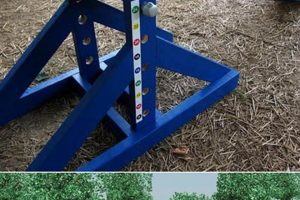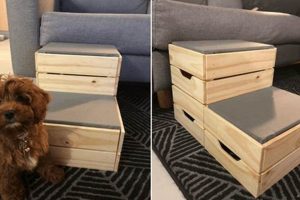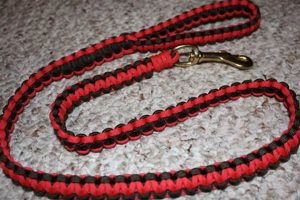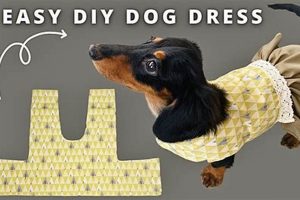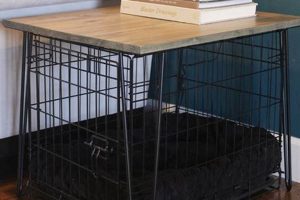A self-constructed elevated platform for canine rest and relaxation provides a comfortable and supportive sleeping area. It typically involves utilizing readily available materials and basic construction techniques to create a bed that is raised off the ground. This type of project allows for customization in size, design, and materials to suit an individual dog’s needs and the owner’s aesthetic preferences.
Elevating a dog’s bed can offer several advantages, including improved air circulation to help regulate temperature and reduce the risk of mold or mildew growth. It can also provide relief for dogs with arthritis or joint pain by reducing the strain of getting up and lying down. Historically, elevated beds have been used in kennels and professional settings to promote hygiene and comfort, and their popularity has extended to home environments due to the recognized benefits for canine well-being.
The following sections will explore the various aspects of creating such a structure, including material selection, construction methods, design considerations, and safety precautions. Detailed instructions and example projects will be provided to guide the reader through the building process.
Construction Guidance
The following tips provide guidance for constructing a durable and functional elevated canine resting platform. Adherence to these suggestions can improve the longevity and safety of the finished product.
Tip 1: Material Selection. Prioritize durable, non-toxic materials suitable for outdoor or indoor use, depending on the intended placement. Pressure-treated lumber is recommended for outdoor applications to resist rot and insect damage. Avoid materials containing harmful chemicals that could be ingested by the animal.
Tip 2: Accurate Measurement. Obtain precise measurements of the dog’s dimensions while lying down to determine appropriate bed size. Add several inches to each dimension to allow for comfortable movement and prevent the dog from feeling confined.
Tip 3: Secure Fasteners. Employ screws or bolts, rather than nails, to assemble the frame. Screws and bolts provide a stronger and more stable connection, reducing the risk of structural failure over time. Countersink all fasteners to prevent injury.
Tip 4: Fabric Choice. Select a durable, washable, and breathable fabric for the sleeping surface. Outdoor-rated fabrics are resistant to water and UV damage, while indoor fabrics should be chosen for comfort and ease of cleaning. Consider using a mesh material for enhanced ventilation.
Tip 5: Sturdy Leg Design. Reinforce the legs of the structure to ensure adequate weight support. Angle the legs slightly outward to increase stability and prevent tipping. Consider using rubber feet or pads to prevent scratching of floors.
Tip 6: Smooth Surfaces. Sand all exposed wood surfaces to eliminate splinters and sharp edges. Apply a non-toxic sealant or paint to protect the wood and prevent moisture absorption. Regularly inspect the structure for signs of wear and tear.
Tip 7: Weight Capacity. Account for the dog’s weight when designing the frame. Use thicker lumber and more robust fasteners for larger breeds to prevent structural collapse. Test the structure thoroughly before allowing the dog to use it.
By following these guidelines, a functional and safe elevated resting platform can be created, providing a comfortable and supportive space for a canine companion.
These insights offer a foundation for successfully constructing a raised canine bed. The subsequent stages will delve into design intricacies and finishing touches.
1. Structural Integrity
Structural integrity is a fundamental requirement in the successful construction of an elevated platform for canines. It directly impacts the bed’s capacity to safely support the dog’s weight over an extended period. Deficiencies in structural design or construction can lead to collapse, resulting in potential injury to the animal. The connection can be demonstrated through a simple cause-and-effect relationship: inadequate bracing or weak joints cause structural failure; structural failure causes the bed to collapse, posing a risk of harm to the occupant. The choice of materials, joinery techniques, and load-bearing capacity calculations are all critical determinants of structural integrity.
Examples of structural failures range from the use of undersized lumber that sags under load to poorly executed joints that separate over time. Consider a situation where untreated pine lumber, known for its lower strength compared to hardwood, is used for the bed’s frame without adequate internal supports. The weight of a large breed dog, such as a Great Dane, could cause the frame to bow and eventually break. Conversely, employing robust materials like pressure-treated lumber or metal framing, coupled with reinforced corners and strategically placed supports, significantly enhances the structure’s load-bearing capability. Proper screw selection is also essential, given the screw could split the wood and the structural integrity will fail.
In conclusion, structural integrity is not merely a desirable attribute but a non-negotiable necessity in elevated canine bed construction. Its absence compromises the safety and longevity of the bed. Addressing this facet through careful material selection, thoughtful design, and diligent construction methods ensures a secure and reliable resting place for the dog. Ignoring this aspect increases the risks of failure, rendering the bed unsafe and negating the investment of time and resources.
2. Material Safety
Material safety constitutes a critical factor in the construction of elevated canine beds, directly influencing the health and well-being of the animal. The selection of appropriate materials mitigates potential risks associated with toxicity, allergenicity, and physical hazards. Understanding these elements is paramount for ensuring a safe resting environment.
- Toxicity of Finishes and Coatings
Paints, stains, and sealants often contain volatile organic compounds (VOCs) and heavy metals that can be harmful if ingested or inhaled. For instance, lead-based paints, though largely phased out, remain a concern in older materials. Dogs, especially puppies, may chew on the bed frame, potentially ingesting these toxic substances. Employing water-based, non-toxic finishes and ensuring proper curing before use can minimize this risk. Certifications such as GreenGuard provide assurance of low chemical emissions.
- Fabric Composition and Allergens
Certain fabrics, particularly those treated with formaldehyde or containing synthetic dyes, can trigger allergic reactions in sensitive dogs. Natural fibers like cotton or hemp, or hypoallergenic synthetic alternatives, are preferable. For example, a dog with a known allergy to wool should not be provided a bed made with wool fibers. Regularly washing the bed covering can also reduce allergen accumulation.
- Sharp Edges and Protrusions
The physical design and construction of the bed must minimize sharp edges, splinters, and protruding fasteners. Dogs can be injured by contact with these hazards, leading to cuts, scrapes, or even puncture wounds. Sanding down rough surfaces, countersinking screws, and using rounded edges in the design can prevent these injuries. Regular inspection and maintenance are necessary to identify and address any developing hazards.
- Structural Integrity and Material Degradation
The long-term safety of the elevated bed depends on the durability and stability of the chosen materials. Materials prone to rapid degradation, such as untreated lumber susceptible to rot or brittle plastics, can compromise the structure’s integrity. Choosing materials with appropriate strength and resistance to environmental factors, such as pressure-treated lumber for outdoor use, ensures a longer lifespan and reduces the risk of collapse.
In summary, material safety in elevated canine bed construction necessitates a comprehensive understanding of potential hazards and the selection of appropriate alternatives. The considerations regarding coatings, fabrics, and structural components ensures a safe and supportive resting environment for the dog. Thorough assessment and mindful selection mitigates the risks inherent in the materials, thereby contributing to the animal’s overall well-being.
3. Air Circulation
Elevated canine beds directly facilitate improved air circulation beneath the resting surface. This enhanced airflow mitigates the accumulation of moisture and reduces the risk of mold or mildew growth, creating a more hygienic environment. The absence of adequate ventilation can trap heat, particularly in warmer climates, leading to discomfort and potential overheating for the animal. Consider, as an example, a bed placed directly on a concrete floor during the summer months; the concrete retains heat, which can then radiate upwards, increasing the dog’s body temperature. An elevated bed, however, allows air to circulate freely, dissipating heat and maintaining a more comfortable temperature.
Furthermore, improved air circulation can be particularly beneficial for dogs with allergies or skin conditions. The reduction in moisture inhibits the growth of bacteria and fungi that can exacerbate these conditions. In practical terms, a dog prone to hot spots or skin infections may experience fewer flare-ups when resting on an elevated bed due to the drier and better-ventilated environment. The design of the bed can further enhance airflow, through the utilization of mesh fabrics for the sleeping surface, or the incorporation of open-slat designs within the frame structure. The bed’s height is also relevant: a greater elevation typically allows for better air movement.
In summary, air circulation is a significant design consideration in the construction of raised beds for canines. Its contribution to hygiene, temperature regulation, and the prevention of dermatological issues directly impacts the dog’s comfort and health. Prioritizing adequate ventilation through thoughtful design and material selection is vital, transforming the bed from a mere resting place to a proactive element in the animal’s overall well-being. Addressing this element optimizes the functionality and benefits of the elevated resting platform.
4. Size Appropriateness
Proper dimensional design of an elevated canine bed is essential for functionality and animal well-being. An inappropriately sized bed undermines the intended benefits of elevation, compromising comfort, safety, and therapeutic advantages. Adherence to appropriate size parameters constitutes a fundamental design criterion.
- Length and Width Considerations
The length and width of the platform must accommodate the dog’s full body length when lying down in a relaxed position. Insufficient dimensions force the animal to contort or hang off the edges, negating the supportive function of the elevated surface. For example, a German Shepherd requires a substantially larger bed than a Dachshund. Precise measurements, accounting for the dog’s typical sleeping posture, are essential before commencing construction.
- Height of Elevation
The height of the bed off the ground should facilitate ease of access for the animal, particularly for older dogs or those with joint issues. Excessive height necessitates undue strain during entry and exit, while insufficient elevation fails to provide the intended benefits of air circulation and pressure relief. A generally accepted height is one that allows the dog to step on and off the bed with minimal effort, taking into account their leg length and mobility.
- Weight-Bearing Capacity
The dimensions of the bed are intrinsically linked to its load-bearing capacity. Larger beds necessitate stronger materials and reinforcement to support the dog’s weight. Underestimation of the required weight capacity can result in structural failure, posing a safety hazard. For example, a small breed dog might be adequately supported by a frame constructed of thinner lumber, whereas a larger breed requires a more robust framework.
- Impact on Mobility and Joint Health
A properly sized bed facilitates natural movement and reduces stress on joints. Confined spaces can exacerbate existing conditions or create new musculoskeletal problems. For example, a dog with arthritis benefits from a bed that allows it to stretch out fully without encountering restrictive edges. Therefore, dimensional planning must prioritize unrestricted movement and ergonomic support.
In conclusion, size appropriateness directly influences the functionality and therapeutic benefits of an elevated canine resting platform. Accurate measurement, consideration of the dog’s physical condition, and adequate structural support are paramount. An inappropriately sized bed compromises the animal’s comfort, safety, and well-being, thereby undermining the purpose of creating a dedicated, elevated space.
5. Comfort Surface
The nature of the upper surface of a self-constructed elevated canine bed significantly influences its usability and the animal’s overall well-being. Material selection and design elements contribute directly to the comfort and support provided. Therefore, careful consideration is required to optimize this aspect of the bed.
- Material Selection and Pressure Distribution
The choice of material significantly impacts pressure distribution across the dog’s body. Dense materials, such as thin layers of firm foam, can create pressure points, leading to discomfort and potential joint pain. Conversely, materials like memory foam or thick layers of softer batting conform to the dog’s shape, distributing weight evenly and reducing pressure. The material should also exhibit sufficient resilience to prevent bottoming out, particularly for heavier dogs.
- Thermal Properties and Breathability
The thermal properties of the comfort surface influence the dog’s ability to regulate its body temperature. Materials that trap heat, such as vinyl or non-breathable synthetics, can lead to overheating, particularly in warmer climates. Breathable fabrics like cotton or linen, or specialized cooling fabrics, promote airflow and help maintain a comfortable temperature. The material’s breathability is especially critical when the bed is intended for use in enclosed spaces or during warmer seasons.
- Texture and Sensory Input
The texture of the comfort surface provides sensory input that can influence the dog’s comfort and relaxation. Some dogs prefer smooth surfaces, while others prefer textured or plush materials. Abrasive or irritating textures should be avoided, as they can cause skin irritation or discomfort. The selection of appropriate texture should be based on the dog’s individual preferences and sensitivities.
- Durability and Maintenance
The durability of the comfort surface dictates its longevity and resistance to wear and tear. Materials prone to tearing, pilling, or rapid degradation require frequent replacement. Durable fabrics like canvas or outdoor-rated synthetics withstand regular use and cleaning. Easy maintenance is also essential for hygiene purposes; removable and machine-washable covers simplify cleaning and prevent the buildup of dirt, allergens, and bacteria.
These facets of the comfort surface are integral to the successful implementation of a “diy raised dog bed.” Attention to material properties, thermal regulation, sensory considerations, and durability contributes to creating a resting space that promotes canine comfort, health, and well-being.
6. Ease of Cleaning
Maintaining a sanitary environment for canine companions necessitates consideration of ease of cleaning in the design and construction of elevated beds. This aspect directly impacts hygiene, odor control, and the prevention of parasitic infestations, requiring diligent attention during the building process.
- Removable and Washable Covers
The inclusion of removable and machine-washable covers significantly simplifies the cleaning process. This feature allows for regular laundering to eliminate dirt, dander, and potential allergens that accumulate over time. For instance, a cover constructed from durable canvas or water-resistant fabric can be easily removed and cleaned, preventing the proliferation of bacteria and odors within the bed’s structure. The alternative, a permanently affixed cover, presents challenges in thorough cleaning and maintenance.
- Water-Resistant Materials
The selection of water-resistant or waterproof materials for the bed’s frame and interior components prevents the absorption of liquids, such as urine or spilled water. This minimizes the risk of mold and mildew growth, which can pose health hazards to both the animal and the environment. Materials like sealed wood or plastic resist moisture penetration, facilitating easier cleaning and preventing long-term damage. Conversely, porous materials like untreated wood readily absorb liquids, creating a breeding ground for microorganisms.
- Smooth and Accessible Surfaces
Designing the bed with smooth, non-porous surfaces simplifies the removal of dirt and debris. Intricate designs with crevices or textured surfaces can trap contaminants, making thorough cleaning difficult. Smooth surfaces, on the other hand, allow for easy wiping and disinfection. The accessibility of all areas of the bed is also crucial, ensuring that no hidden spaces accumulate dirt or moisture. A design that allows complete access to all components enhances the effectiveness of cleaning efforts.
- Resistance to Parasite Infestation
Materials that resist parasite infestation contribute to the overall hygiene of the bed. Certain fabrics and coatings repel fleas, ticks, and other parasites, preventing them from establishing a foothold within the bed’s structure. Treating the wood frame with a non-toxic insecticide or using tightly woven fabrics can minimize the risk of infestation. Regular cleaning and inspection further deter parasites, ensuring a healthier resting environment for the animal.
Consideration of ease of cleaning directly contributes to the hygiene and longevity of elevated canine beds. The integration of removable covers, water-resistant materials, smooth surfaces, and parasite-resistant components ensures a sanitary and comfortable resting space. Ignoring these factors compromises the overall health and well-being of the animal. The ease of maintenance transforms the bed from a potential source of contamination into a clean and supportive environment.
7. Design Customization
The inherent nature of self-construction lends itself to design customization, allowing the creation of an elevated canine bed tailored to specific needs, aesthetic preferences, and spatial constraints. This adaptability differentiates a “diy raised dog bed” from commercially available, standardized products.
- Size and Dimensional Adaptation
Design customization permits precise scaling of the bed to match the dimensions of the dog and the available space. Standard beds often present compromises in size, either too large for smaller areas or too small for larger breeds. A self-constructed bed allows for the creation of a perfectly fitted structure, maximizing space utilization and canine comfort. For instance, a narrow, elongated bed can be designed for placement along a hallway, or a compact, square bed can be crafted for a corner location.
- Material Selection and Aesthetic Integration
Design customization extends to material selection, enabling the builder to choose materials that complement existing home decor and meet specific requirements. Wood type, fabric patterns, and finish colors can be selected to harmonize with the surrounding environment. A modern home might utilize sleek metal framing and minimalist fabric, while a rustic setting could incorporate reclaimed wood and textured textiles. This level of aesthetic integration is often unattainable with mass-produced options.
- Functionality and Adaptability
Design customization facilitates the incorporation of specific functional elements. Elevated feeders, integrated storage compartments, or orthopedic support systems can be seamlessly integrated into the bed’s design. A bed designed for an older dog might include a ramp or low-profile entry, while a bed for a dog prone to anxiety could feature enclosed sides for a sense of security. Such targeted functionality is difficult to find in prefabricated models.
- Personalized Features and Embellishments
Design customization allows for the inclusion of personalized details that reflect the owner’s preferences and the dog’s unique characteristics. Engraved nameplates, custom-stitched cushions, or unique paint schemes can be incorporated to create a truly individual piece. These personal touches transform the bed from a functional object into a cherished item that celebrates the bond between owner and pet.
These customization avenues empower the constructor to create a bespoke resting platform that transcends the limitations of mass-produced alternatives. The ability to fine-tune dimensions, materials, features, and aesthetic elements contributes to a “diy raised dog bed” that optimally serves the needs of both canine and owner, integrating seamlessly into the home environment while promoting the animal’s well-being.
Frequently Asked Questions
The following section addresses common inquiries regarding the construction of elevated resting platforms for canines. The information presented aims to provide clarity on key considerations and best practices.
Question 1: What is the optimal height for an elevated canine bed?
The optimal height is determined by the dog’s size and mobility. The bed should be elevated enough to allow for adequate air circulation underneath, but not so high that it presents a challenge for the dog to enter or exit. As a general guideline, the height should be approximately equal to the dog’s knee height.
Question 2: Are specific wood types recommended for construction?
Durable hardwoods, such as oak or maple, offer superior strength and longevity. Pressure-treated lumber is suitable for outdoor applications, providing resistance to rot and insect damage. Softwoods, like pine, can be used for indoor beds, but should be properly sealed to prevent splintering and moisture absorption.
Question 3: What type of fabric is most suitable for the sleeping surface?
Durable, washable fabrics are recommended. Canvas, denim, or outdoor-rated synthetics withstand regular use and cleaning. Breathable fabrics, such as cotton or linen, promote air circulation and prevent overheating. Avoid fabrics with loose weaves that can trap dirt and debris.
Question 4: How can the bed be made resistant to chewing?
Applying a non-toxic, chew-resistant coating to the wooden frame can deter chewing. Encasing exposed edges with metal or durable plastic trim can also prevent damage. Selecting durable fabrics that are less appealing to chewers is also beneficial.
Question 5: What safety precautions should be observed during construction?
Use appropriate safety equipment, including eye protection and gloves, when cutting and assembling materials. Ensure all fasteners are countersunk to prevent injury. Sand all exposed edges to eliminate splinters. Use non-toxic finishes and allow them to fully cure before allowing the dog to use the bed.
Question 6: How can the bed’s stability be ensured?
Reinforce the legs of the bed with bracing or gussets. Use strong joinery techniques, such as mortise and tenon or pocket screws. Ensure the base is wider than the top to prevent tipping. Test the bed’s stability before allowing the dog to use it.
In summary, careful planning, material selection, and construction techniques are essential for creating a safe, durable, and comfortable elevated canine bed.
The following section will outline considerations for maintaining and extending the life of the elevated canine bed.
DIY Raised Dog Bed
The foregoing analysis has explored the diverse considerations inherent in constructing an elevated resting platform for canines. Critical elements encompass structural integrity, material safety, air circulation, dimensional accuracy, comfort provision, ease of maintenance, and design personalization. The successful execution of a diy raised dog bed project mandates meticulous attention to these facets, translating conceptual planning into a tangible and functional asset.
The construction of such a bed represents a commitment to canine well-being, extending beyond mere shelter to encompass considerations of health, hygiene, and personalized comfort. Diligence in adhering to established best practices ensures the creation of a durable and safe haven for the animal, while simultaneously contributing to a cleaner and more aesthetically pleasing domestic environment. This undertaking, undertaken with care and precision, yields a tangible benefit for both canine and caretaker.


